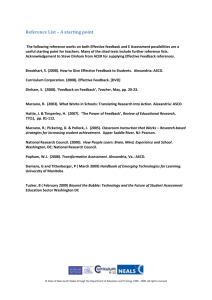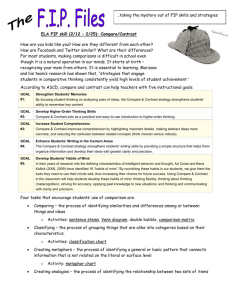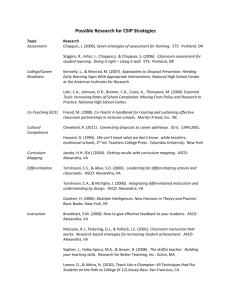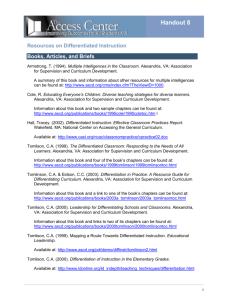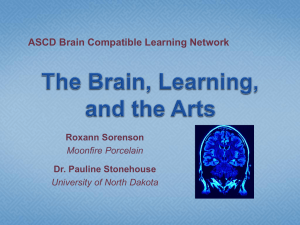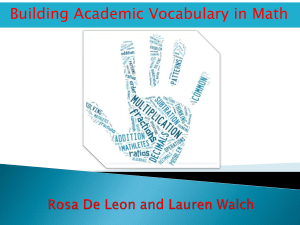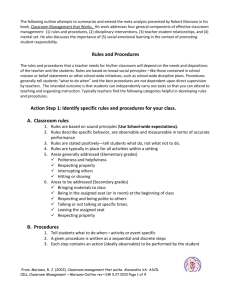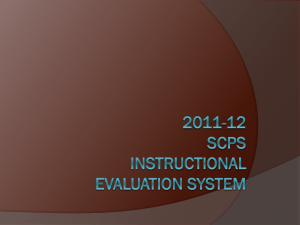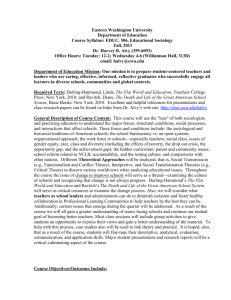Research-Based Best Practices Aligned with Critical Success
advertisement
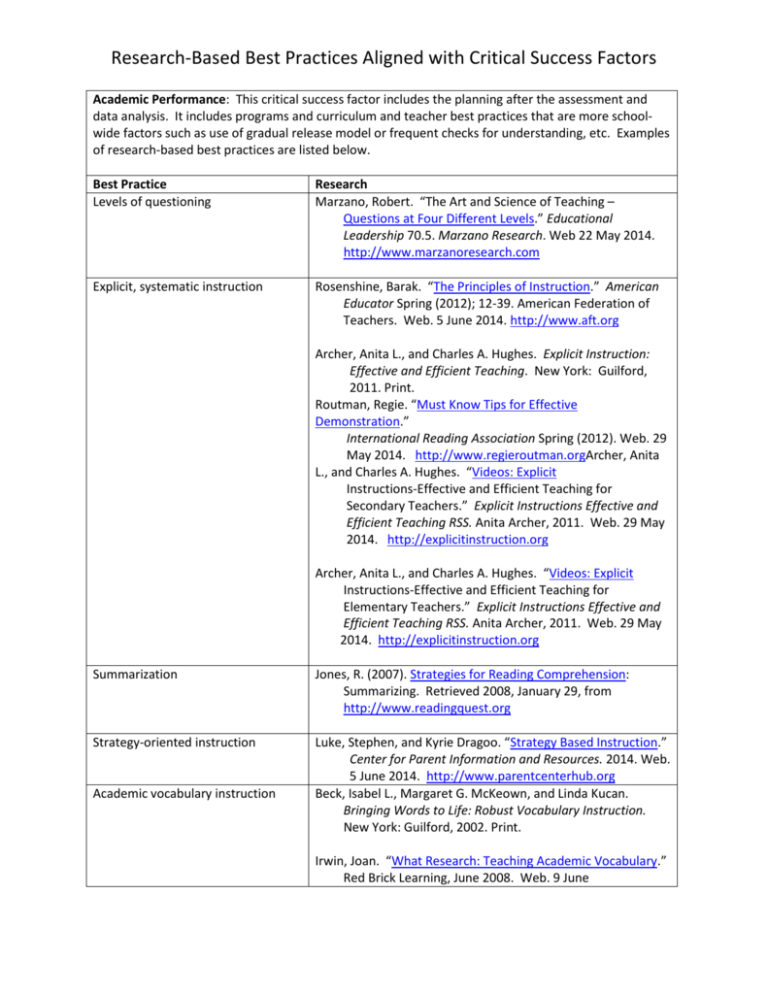
Research-Based Best Practices Aligned with Critical Success Factors Academic Performance: This critical success factor includes the planning after the assessment and data analysis. It includes programs and curriculum and teacher best practices that are more schoolwide factors such as use of gradual release model or frequent checks for understanding, etc. Examples of research-based best practices are listed below. Best Practice Levels of questioning Research Marzano, Robert. “The Art and Science of Teaching – Questions at Four Different Levels.” Educational Leadership 70.5. Marzano Research. Web 22 May 2014. http://www.marzanoresearch.com Explicit, systematic instruction Rosenshine, Barak. “The Principles of Instruction.” American Educator Spring (2012); 12-39. American Federation of Teachers. Web. 5 June 2014. http://www.aft.org Archer, Anita L., and Charles A. Hughes. Explicit Instruction: Effective and Efficient Teaching. New York: Guilford, 2011. Print. Routman, Regie. “Must Know Tips for Effective Demonstration.” International Reading Association Spring (2012). Web. 29 May 2014. http://www.regieroutman.orgArcher, Anita L., and Charles A. Hughes. “Videos: Explicit Instructions-Effective and Efficient Teaching for Secondary Teachers.” Explicit Instructions Effective and Efficient Teaching RSS. Anita Archer, 2011. Web. 29 May 2014. http://explicitinstruction.org Archer, Anita L., and Charles A. Hughes. “Videos: Explicit Instructions-Effective and Efficient Teaching for Elementary Teachers.” Explicit Instructions Effective and Efficient Teaching RSS. Anita Archer, 2011. Web. 29 May 2014. http://explicitinstruction.org Summarization Jones, R. (2007). Strategies for Reading Comprehension: Summarizing. Retrieved 2008, January 29, from http://www.readingquest.org Strategy-oriented instruction Luke, Stephen, and Kyrie Dragoo. “Strategy Based Instruction.” Center for Parent Information and Resources. 2014. Web. 5 June 2014. http://www.parentcenterhub.org Beck, Isabel L., Margaret G. McKeown, and Linda Kucan. Bringing Words to Life: Robust Vocabulary Instruction. New York: Guilford, 2002. Print. Academic vocabulary instruction Irwin, Joan. “What Research: Teaching Academic Vocabulary.” Red Brick Learning, June 2008. Web. 9 June Research-Based Best Practices Aligned with Critical Success Factors 2014. http://www.capstonepub.com Essential Questions McTighe, Jay, and Grant Wiggins. Essential Questions: Opening the Door to Student Understanding. ASCD, 2013. Print. Understanding by design Wiggins, Grant P., and Jay McTighe. Understanding by Design. ASCD, 2005. Print. Inquiry-based learning Barron, Brigid, and Linda Darling-Hammond. Teaching for Meaningful Learning: A Review of Research on InquiryBased and Cooperative Learning. George Lucas Educational Foundation, 2008. Web. 14 June 2014. http://www.edutopia.org Thomas, John. W. “A Review of Research on Project-Based Learning.” New Tech Network, 2000. Web. 10 June 2014. http://www.newtechnetwork.org Sheltered Instruction Wallace, Susan. “Effective Instructional Strategies for English Language Learners in the Mainstream Classroom.” New Horizons. Johns Hopkins University, 2004. Web. 9 June 2014. http://education.jhu.edu Echevarria, Jana, Jennifer Himmel, Deborah Short, and Catherine Richards. “Using the SIOP Model to Improve Middle School Science Instruction.” (2009). CREATE Center for Research on the Education, Achievement and Teaching of English Language Learners. California State University, May 2009. Web 10 June 2014. Goldenberg, Claude. “Understanding and Teaching EnglishLanguage Learners: What the Research Says and Doesn’t Say.” American Educator Summer (2008). Northwest Regional ESD. 2008. Web. 10 June 2014. http://ell.nwresd.org Engagement and motivation strategies Marzano, Robert J. “The Highly Engaged Classroom.” Marzano Research Laboratory. Marzano Research Laboratory, Mar.2011. Webinar. 22 May 2014. http://www.marzanoresearch.com Cooperative Learning Barron, Brigid, and Linda Darling-Hammond. Teaching for Meaningful Learning: A Review of Research on InquiryBased and Cooperative Learning. George Lucas Educational Foundation, 2008. Web. 14 June 2014. http://www.edutopia.org Research-Based Best Practices Aligned with Critical Success Factors Kagan, Spencer. “Kagan Publishing and Professional Development.” Articles on Cooperative Learning. Kagan Online.com, 2014. Web. 14 June 2014. http://www.kaganonline.com Visual literacy Wood, Katie Ray. In Pictures and in Words: Teaching the Qualities of Good Writing through Illustration Study. Portsmouth, NH: Heinemann, 2010. Print. Concept-based learning Erickson, H. Lynn and Lois A. Lanning. Transitioning to ConceptBased Curriculum and Instruction. Thousand Oaks, CA: Corwin Press, 2014. Print. Guthrie, J. T. (2003). Concept-Oriented Reading Instruction: Practices of Teaching Reading for Understanding. In C. Snow & A. Sweet (Eds.), Reading for Understanding: Implications of RAND Report for Education (pp. 115-140). New York: Guilford. http://www.rand.org Formative assessment “Research Brief: What Does Research Say the Benefits of Formative Assessment Are?” (2007). National Council of Teachers of Math. 2007. Web 9 June 2014. http://www.nctm.org Pinchok, Nick, and W. Christopher Brandt. “Connecting Formative Assessment Research to Practice.” Learning Point Associates, 2009. Web. 9 June 2014. http://www.learningpt.org Zone of proximal development Lui, Angela. “White Paper: Teaching in the Zone.” (2012). Children’s Progress. Web. 9 June 2014. http://www.childrensprogress.com Teaching skills in context Chin, Beverly Ann. “The Role of Grammar in Improving Student’s Writing.” University of Wisconsin Platteville, 2000. Web. 9 June 2014. http://people.uwplatt.edu Differentiated instruction Tomlinson, Carol A. The Differentiated Classroom: Responding to the Needs of All Learners. ASCD, 2014. Print. Tomlinson, Carol A. and Toya Moon. Assessment and Student Success in the Differentiated Classroom. ASCD, 2013. Print. Reading Strategies “ERIC – Evidence-Based Reading Instruction: Putting the National Reading Panel Report into Practice, 2002.” International Reading Association, 2002. Web. 5 June Research-Based Best Practices Aligned with Critical Success Factors 2014. http://eric.ed.gov Reading aloud “Research from the National Reading Panel.” Mempowered. National Reading Panel. Web 5 June 2014. http://www.memory-key.com Fluency strategies Rasinski, Timothy. “Creating Fluent Readers.” Educational Leadership (2004): 46-51. Web. 14 June 2014. http://www.educationalleader.com Phonics/phonemic awareness “Research from the National Reading Panel.” Mempowered. National Reading Panel. Web 5 June 2014. http://www.memory-key.com Guided reading Fountas, Irene, and Gay Su Pinnell. Guided Reading: Good First Teaching for All Children. Heinemann, 1996. Print. “Research from the National Reading Panel.” Mempowered. National Reading Panel. Web 5 June 2014. http://www.memory-key.com Curriculum Audit English, Fenwick W., and Betty E. Steffy. Deep Curriculum Alignment: Creating a Level Playing Field for All Children on High-stakes Tests of Educational Accountability. Lanham, MD: Scarecrow Education, 2001. Print. Marzano, Robert J. What Works in Schools: Translating Research into Action. Alexandria, VA: ASCD, 2003. Print. Brown, John L., and Grant P. Wiggins. Making the Most of Understanding by Design. Alexandria, VA: ASCD, 2004. Print. Guaranteed and Viable Curriculum English, Fenwick W., and Betty E. Steffy. Deep Curriculum Alignment: Creating a Level Playing Field for All Children on High-stakes Tests of Educational Accountability. Lanham, MD: Scarecrow Education, 2001. Print. Wiggins, Grant P., and Jay McTighe. Understanding by Design. Upper Saddle River: Pearson, 2006. Print. Brown, John L., and Grant P. Wiggins. Making the Most of Understanding by Design. Alexandra, VA: ASCD, 2004. Print. Research-Based Best Practices Aligned with Critical Success Factors Curriculum Aligned to Standards, Assessments and Instruction English, Fenwick W., and Betty E. Steffy. Deep Curriculum Alignment: Creating a Level Playing Field for All Children on High-stakes Tests of Educational Accountability. Lanham, MD: Scarecrow Education, 2001. Print. Ravitch, Diane. National Standards in American Education: A Citizen’s Guide. Washington, D.C.: Brookings, 1995. Print. Wiggins, Grant P., and Jay McTighe. Understanding by Design. Upper Saddle River: Pearson, 2006. Print. Zagranski, Richard, William T. Whigham, and Patrice L. Dardenne. Understanding Standards-based Education: A Practical Guide for Teachers and Administrators. Thousand Oaks, CA: Corwin, 2008. Print. Taylor, Rosemarye, and Valerie Doyle Collins. Literacy Leadership for Grades 5-12. Alexandria, VA: ASCD, 2003. Print. Marzano, Robert J. “Designing and Teaching Learning Goals and Objectives Webinar.” Marzano Research Laboratory. Marzano Research Laboratory, April 2011. Webinar. 22 May 2014. http://www.marzanoresearch.com Tyler, Ralph W., and Peter S. Hlebowitsh. Basic Principles of Curriculum and Instruction. Chicago: U of Chicago, 2013. Print. Ainsworth, Larry. Rigorous Curriculum Design: How to Create Curricular Units of Study that Align Standards, Instruction, and Assessment. Englewood, CO: Lead Learn, 2010. Print. "Vertical Alignment: Ensuring Opportunity to Learn in a Standards-Based Curriculum." ISSUE BRIEF (2009). The Center for Comprehensive School Reform and Improvement, 15 Aug. 2009. Web. 16 Sept. 2014. http://www.centerforcsri.org. “Aligned Curriculum and Student Achievement.” Research Brief: Appalachia Educational Laboratory at Edvantia, Dec. 2005. Effective Instructional Design Marzano, Robert J. The Art and Science of Teaching: A Comprehensive Framework for Effective Instruction. Alexandria, VA: ASCD, 2007. Print. Research-Based Best Practices Aligned with Critical Success Factors Popham, W. James. Transformative Assessment. Alexandria, VA: ASCD, 2008. Print. Wiggins, Grant P., and Jay McTighe. Understanding by Design. Upper Saddle River: Pearson, 2006. Print. Dean, Ceri, B., and Robert J. Marzano. Classroom Instruction that Works: Research-based Strategies for Increasing Student Achievement. Alexandria, VA: ASCD, 2012. Print. Curriculum Implementation Monitoring Mooney, Nancy J., and Ann T. Mausbach. Align the Design: A Blueprint for School Improvement. Alexandria, VA: ASCD, 2008. Print. Tanner, Daniel, and Laurel N. Tanner. Supervision in Education: Problems and Practices. New York: Macmillan, 1987. Print. City, Elizabeth A. Instructional Rounds in Education: A Network Approach to Improving Teaching and Learning. Cambridge, MA: Harvard Education, 2009. Print. Fidelity to the Curriculum Marzano, Robert J. What Works in School: Translating Research into Action. Alexandria, VA: ASCD, 2003. Print. Downey, Carolyn J. 50 Ways to Close the Achievement Gap. Thousand Oaks, CA: Corwin, 2009. Print. Effective Instructional Improvement Planning Process Jacobs, Heidi Hayes. Getting Results with Curriculum Mapping. Alexandria, VA: ASCD, 2004. Print. Stronge, James H. Qualities of Effective Teachers. Alexandria, VA: ASCD, 2002. Print. Dean, Ceri B., and Robert J. Marzano. Classroom Instruction that Works: Research-based Strategies for Increasing Student Achievement. Alexandria, VA: ASCD, 2012. Print. Unpacking Standards to Define Instructional Targets Wiggins, Grant P., and Jay McTighe. Understanding by Design. Upper Saddle River: Pearson, 2006. Print. Zemelman, Steven, Harvey Daniels, and Arthur A. Hyde. Best Practice: Today’s Standards for Teaching and Learning in America’s Schools. Portsmouth, NH: Heinemann, 2005. Print. Research-Based Best Practices Aligned with Critical Success Factors Horizontal and Vertical Alignment English, Fenwick W., and Betty E. Steffy. Deep Curriculum Alignment: Creating a Level Playing Field for All Children on High-stakes Tests of Educational Accountability. Lanham, MD: Scarecrow Education, 2001. Print.
